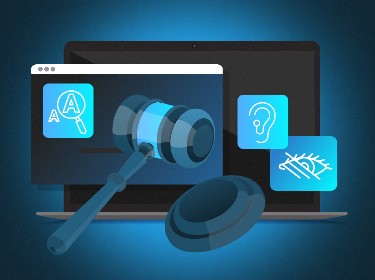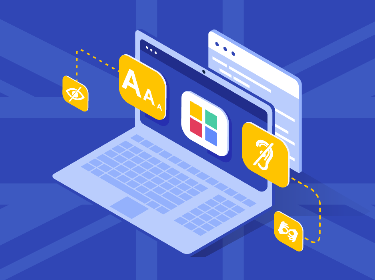Web accessibility ensures an inclusive online experience, breaking down barriers and enabling individuals with disabilities to engage fully with digital content.
Creating a fully compliant website is undoubtedly challenging, but it is also immensely rewarding and crucial for modern businesses. By prioritizing web accessibility, you enhance customer engagement and experience, minimize legal risks, and position your business as forward-looking and customer-centric.
To illustrate the profound importance, our web development company invites you to explore these 20 key web accessibility statistics and perspectives that highlight the significant impact of compliant websites.
Top 20 must-know web accessibility statistics and insights of 2024 and beyond
Let’s delve into the most current and enlightening web accessibility statistics to grasp their relevance and uncover the critical importance of web accessibility.
1. The global web accessibility software market size is expected to reach $893.7 million by 2031.
2. The State of Digital Accessibility Report 2023-2024 by Level Access shows that 72% of organizations have a digital accessibility policy and 85% see it as a competitive advantage.
3. Gartner’s 2023 Market Guide for Digital Accessibility suggests that computer vision solutions, or visual artificial intelligence, could greatly enhance accessibility scanning tools’ efficiency, possibly reducing or even eliminating the need for manual testing to identify accessibility issues.
4. The global digital accessibility software market, divided into North America, Europe, Asia Pacific, and the rest of the world, sees North America leading in market share, followed by Europe, due to its robust ICT sector fostering an environment conducive to digital accessibility software development.
5. According to Business Research Insights, the global market for smart website accessibility tools is projected to reach $993.62 million by 2031.
6. According to web accessibility statistics from Infosys, the absence of digital accessibility is identified as one of the primary causes of digital friction.
7. According to the WebAIM Million 2023 report, among one million home pages analyzed, a total of 49,991,225 distinct accessibility errors were detected, averaging 50 errors per page.
8. The 2023 Digital Accessibility Index report by AudioEye reveals that digital experiences are inadequate for 1.3 billion people with disabilities worldwide.
9. In 2023, there was a significant increase in ADA digital accessibility lawsuits, with a total of 4,605 reported cases. This represented a 14.1% rise from the 4,035 cases reported in 2022, marking a notable surge in the landscape of ADA digital accessibility litigation.
10. As reported by Straits Research, the global accessibility testing market size is expected to reach $606.46 million by 2027.
11. Based on Statista’s web accessibility statistics, as of October 2023, the global internet user count stood at 5.3 billion individuals, equivalent to 65.7% of the world’s population. Within this figure, 4.95 billion people, or 61.4% of the global populace, were actively engaged on social media platforms.
12. Projected to experience substantial revenue growth and exponential market expansion, the digital accessibility service market is poised for significant advancement. This growth is largely driven by the escalating demand for digital accessibility services globally, particularly within sectors such as education, government, healthcare, and retail software solutions.
13. According to the web accessibility statistics provided by Verified Market Research, the global market for transcription services is projected to grow to $16.6 billion by 2027. This growth is driven by higher demand in healthcare and legal industries, significant investments in artificial intelligence, and an increasing need for automated transcription solutions.
14. WCAG 2.2, introduced in October 2023, extends WCAG 2.1 by adding new success criteria:
- 2.4.11 Focus Not Obscured (Minimum) (AA)
- 2.4.12 Focus Not Obscured (Enhanced) (AAA)
- 2.4.13 Focus Appearance (AAA)
- 2.5.7 Dragging Movements (AA)
- 2.5.8 Target Size (Minimum) (AA)
- 3.2.6 Consistent Help (A)
- 3.3.7 Redundant Entry (A)
- 3.3.8 Accessible Authentication (Minimum) (AA)
- 3.3.9 Accessible Authentication (Enhanced) (AAA)
15. The key findings from the 2023 report on the accessibility of the top 1,000,000 home pages include:
- 83.6% of home pages had low-contrast text issues
- 22.1% of images lacked alternative text
- ARIA code usage increased by 29%
- Home page complexity rose by 10%
- Form inputs increased by 13.8%, with 35.8% lacking proper labels
16. In 2023, eCommerce websites topped the list in lawsuits, with the food service sector in second place, and education following closely behind.
The high number of legal challenges against eCommerce sites was due to their increasing online presence, frequent updates, and complex features. The education sector, experiencing a surge in lawsuits with one firm filing 100 out of 104 cases, entered the top three for the first time, indicating rising legal complexities in this area.
17. Further web accessibility statistics provided by McKinsey reveal that consumer companies lose $6.9 billion annually because of inaccessible websites, as consumers with disabilities opt for competitors. This cost is expected to rise by 2030 with the increasing demand for accessible services, attributed to the aging global population.
18. The Space Telescope Science Institute (STScI) and Tactile Images teamed up to produce a tactile version of a James Webb Space Telescope image. They created limited 12″ x 12″ tactile panels for distribution across the country, primarily to make astronomy more accessible to the blind and visually impaired.
19. At the 2023 Artificial Intelligence and Accessibility Research Symposium, the spotlight was on AI’s potential to improve digital accessibility. It was noted that AI assists content creators with accurate descriptions and accessibility in written content. The speakers also delved into AI’s role in text-to-speech technologies and its benefits when used early in content creation.
Discussions included the use of AI in creating accessible code, underscoring the need for training AI on accessible code to avoid past issues. Highlights also encompassed advancements in NLP for accessibility, dialog systems, personalized communication, and AI in aiding complex web navigation and the development of accessible products.
The versatility of AI was further illustrated in its application in academic textbooks, enhancing media descriptions, and supporting individuals with visual impairments in media creation.
20. The City of New York’s Digital Accessibility Report 2023 reveals that Local Law 12, effective since January 2023, requires city agencies to create and update a 5-Year Accessibility Plan focusing on digital access. The law also mandates agencies to release a Website Accessibility Statement and set up a process for reporting accessibility issues.
![]()
Further detail references:
Gartner’s 2023 Market Guide for Digital Accessibility
Enhance your digital accessibility with PixelPlex's expert web development and design services
Web accessibility FAQs
To brush up on our understanding of web accessibility basics, let’s delve into and address some of the most frequently asked questions in this area.
What is web accessibility?
The concept of web accessibility revolves around crafting and shaping websites, tools, and digital platforms that are easy to use for individuals with disabilities. This initiative focuses on accommodating a range of disabilities, such as auditory, cognitive, neurological, physical, speech, and visual challenges.
Why is web accessibility important?
Web accessibility is important as it empowers every individual, including those with disabilities, to garner information and interact seamlessly with digital content. It represents a commitment to inclusivity and equality.
What are the main principles of web accessibility?
Outlined by the Web Content Accessibility Guidelines (WCAG), web accessibility rests on the four pillars:
- Perceivable. Ensuring users can perceive both information and interactive elements.
- Operable. Making sure that interfaces and navigational elements are user-friendly.
- Understandable. Ensuring clarity of information and simplicity in interface operations.
- Robust. Guaranteeing content stability across diverse user agents, including assistive tools.
What are some common accessibility issues?
Frequent obstacles in web accessibility encompass issues like inadequate keyboard navigation, absence of image alt text, low contrast between text and backgrounds, uncaptioned videos, and complex or variable navigation systems.
How can I make my website accessible?
Enhancing website accessibility involves several steps:
- Structuring websites using semantic HTML
- Guaranteeing navigability through keyboard use
- Including descriptive alt text for visual content
- Ensuring text and background colors contrast sufficiently
- Designing accessible forms
- Implementing appropriate ARIA roles and attributes
- Regularly testing the website with specialized tools and obtaining feedback from users with diverse disabilities
Are there legal standards for web accessibility?
Various nations have set legal benchmarks for web accessibility.
In the USA, the Americans with Disabilities Act (ADA) and Section 508 of the Rehabilitation Act are prominent examples. Meanwhile, the WCAG serves as a globally acknowledged benchmark in this domain.
Check out our article on how to conduct a web accessibility audit and take the first step towards ensuring your website meets accessibility standards
Closing thoughts
Web accessibility is about opening your digital doors to everyone, without exception. It enhances user experience and broadens your audience — and in doing so, accessibility turns into an asset.
If you are interested in making your website compliant but uncertain about how to begin, there is no need to worry.
PixelPlex offers a wide range of website accessibility services. We will guide you through every step and ensure that your website meets current standards and is ready for the future. We can assist you with:
- Web accessibility consulting services
- UI/UX design services
- Web accessibility testing
- Web accessibility audit services
Make your website a welcoming place for all. Reach out to PixelPlex, and let’s make the web more accessible together.




